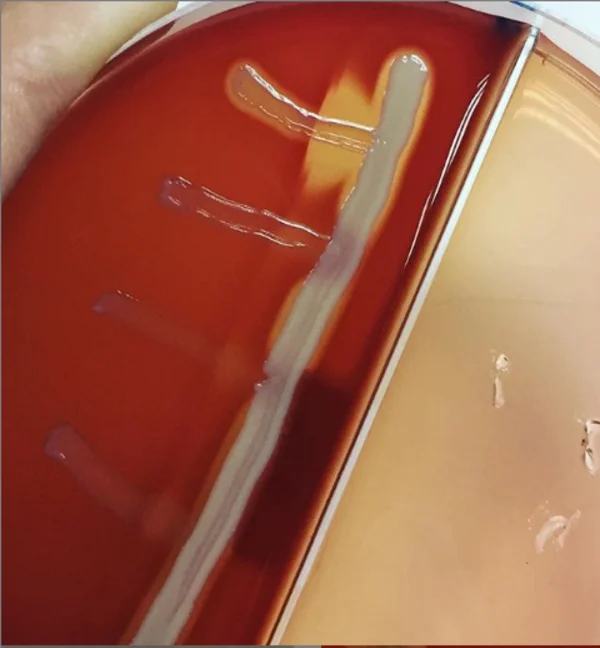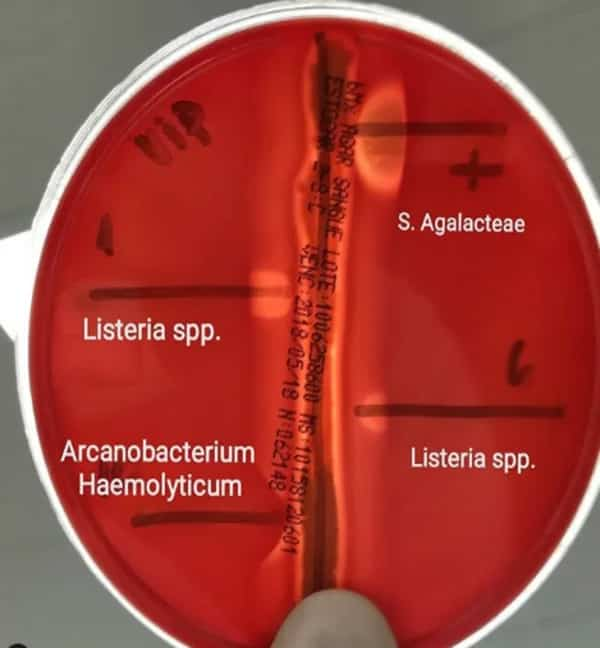Content
The CAMP test, also known as the CAMP co-hemolysis test, is a test used for the presumptive identification of Streptococcus agalactiae.
◉ what is CAMP test?
The CAMP test has been widely used in diagnostic microbiology since its discovery in 1944 by Christie et al. for the presumptive identification of Streptococcus agalactiae, a major pathogen of neonatal infections.
The CAMP reaction is a co-hemolysis phenomenon manifested by an area of strong hemolysis when Streptococcus agalactiae, which produces the CAMP factor, is seeded next to Staphylococcus aureus, which secretes sphingomyelinase, on sheep blood agar.
The term "CAMP" is an acronym formed from the names of the authors of this test (Christie, Atkinson, Munch and Peterson).
CAMP is an acronym for the authors of this test (Christie, Atkinson, Munch, Peterson).
◉ Principle of CAMP test
The CAMP reaction is supported by red blood cells of different mammalian species, but its intensity varies depending on the sphingomyelin content in their cells membranes. Erythrocytes of sheep are rich in sphingomyelin, their sphingomyelin content being up to 51%.
The proteins responsible for the CAMP reaction are S. aureus sphingomyelinase and CAMP factor, a protein secreted by S. agalactiae. Sphingomyelinase initially hydrolyzes sphingomyelin to ceramide, which renders erythrocytes sensitive to the lytic activity of factor CAMP.
This synergistic reaction results in a zone of reinforced and very visible hemolysis in the region between the two cultures.
Note : The CAMP test can also be performed with discs impregnated with beta-lysine. the organism to be identified is inoculated in a straight line within 5 mm of the disc.

CAMP test
◉ Procedure and results
The CAMP test is performed on standard dishes of sheep blood agar or trypticase soy agar +5% sheep blood.
- Using an inoculation loop, streak beta-lysine-producing Staphylococcus aureus (ATCC25923) in a straight line through the center of a plate of sheep blood agar.
- the test organism in a straight line perpendicular to S. aureus leaving a space of 1 cm between the two streaks. (Multiple organisms can be tested on a single plate if spaced 3-4 mm apart).
- Incubate the box at 37 degrees for 18-24 hours
◉ Results : A positive test CAMP appears as an area of arrowhead hemolysis adjacent to where the two lines of streaks come together. A lack of enhanced hemolysis near the colony being tested is a negative CAMP test
◉ CAMP test for the identification of Listeria monocytogenes
In 1962, Fraser, G. was the first to observe the synergistic lysis of sheep red blood cells by L. monocytogenes and S. aureus or Rhodococcus equi.
The CAMP test can be used to differentiate hemolytic Listeria species; L. monocytogenes, L. ivanovii and L. seeligeri.
Hemolysis by L. monocytogenes and to a lesser degree L. seeligeri is enhanced in the vicinity of S. aureus and hemolysis by L. ivanovii is enhanced in the vicinity of the R. equi streak (cholesterol oxidase). Listeria factors responsible for synergistic lysis of red blood cells with S. aureus and Rhodococcus. equi are respectively PLC and LLO (Listeriolysin O).
Note : The CAMP test has been reviewed for its applicability and it has been shown that sometimes it cannot properly differentiate between L. monocytogenes and L. ivanovii
◉ Results : A CAMP test positive appears as a smaller, less obvious rectangular area of hemolysis
◉ The reverse CAMP test
A reverse CAMP reaction is a reaction whereby hemolysis by beta-hemolysin of Staphylococcus aureus (or S. intermedius) is inhibited by the production of phospholipase D (or phospholipase C).
◉ Results : A positive reverse CAMP test appears as An arrow without hemolysis forms at the junction of the test organism with staphylococci. Ex : Corynebacterium pseudotuberculosis , Corynebacterium ulcerans , Arcanobacterium haemolyticum , Mycoplasma hyorhinis , C. perfringens

CAMP test positive(S.agalactiae, Listeria.spp, A.haemolyticum)
◉ Notes
- If the agar is too runny or haemolysed, the reaction may be very weak .
- Isolates with a negative CAMP test could still be S. agalactiae and require further testing .
- S. pyogenes can give a reaction which can be interpreted as positive (S. pyogenes is positive for pyrrolidonyl-β-naphthylamide (PYR) but S. agalactiae is negative for PYR).
- The following Gram-positive bacilli are CAMP positive: Rhodococcus equi, L. monocytogenes, Propionibacterium avidum/granulosum, Actinomyces neuii, Turicella otitidis, Corynebacterium glucuronolyticum, Corynebacterium coyleae, Corynebacterium imitans and certain strains of the Corynebacterium striatum and Corynebacterium afermentans group. (14)
- Prolonged incubation times or high incubation temperatures may give false positive results.
◉ Conclusion
The CAMP test remains a valuable tool in diagnostic microbiology. By examining the phenomenon of co-hemolysis, it aids in the presumptive identification of Streptococcus agalactiae, a significant pathogen in neonatal infections.
It is important to note that additional examinations are essential to establish an accurate diagnosis.